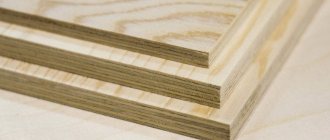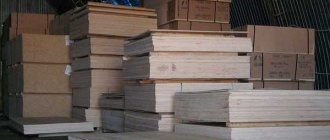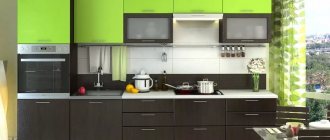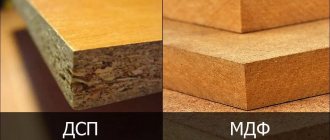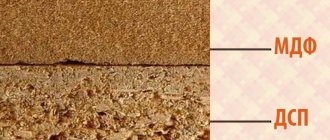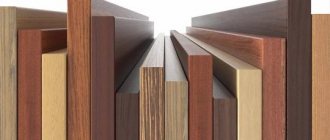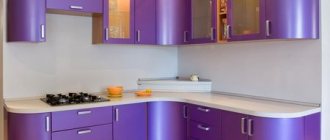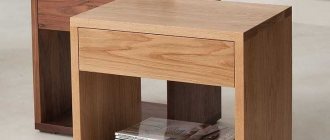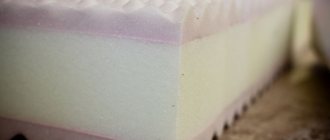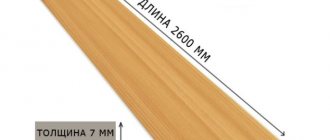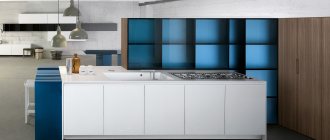Furniture made from chipboard or MDF: which is better to choose?
When buying furniture for your home, you often face a difficult task: what is better to choose - laminated chipboard or MDF.
The slabs are very similar in appearance, the products made from them look approximately the same and at first glance there is no obvious difference. Meanwhile, there are very different differences: in terms of placement, durability and safety. And without having an idea about the features of each material, you will not be able to make the best choice. But everything is not as difficult as it seems. In this article we will tell you how laminated chipboard differs from MDF, about the advantages and disadvantages of the finished product. And also, you will learn what should be taken into account without fail.
And for those who don’t have time to understand all the intricacies of furniture production, at the bottom of the page there is a picture hint “Chipboard or MDF: which is better?” It indicates the main differences between furniture made from these materials and the suitable area of the apartment for placement.
So:
Scope of application
Fiberboard has proven itself to be a reliable component in construction, finishing works, and in the furniture industry. A solid slab is needed to level floors, walls, ceilings, build elevator cabins, install partitions in rooms, build ventilation ducts, and as packaging containers.
Fiberboard for floors, walls and ceilings is also used as soundproofing and heat-insulating materials.
In furniture making, fiberboard is needed for the back walls of cabinets and chests of drawers, as well as the bottom of drawers. Decorative fiberboard wall panels look modern and stylish in place of the kitchen apron.
Chipboard and MDF - what's the difference?
Laminated chipboard, or more correctly, of course, would be chipboard, as industrialists call it, but among the people the name without the letter “t” has stuck. It is produced from waste from the wood processing industry - sawdust, by hot pressing using a formaldehyde-based adhesive resin.
The chipboard is laminated with melamine film and cut into parts. Since the material absorbs moisture well and swells, the ends of the facades are sealed with an edge. This technology not only prevents water from getting inside, but also reduces the release of formaldehyde vapor to a safe minimum.
Russian GOST, adopted in 2010, obliges compliance with safety standards and allows the use of only laminated chipboards of emission class E1 and E0.5 in the furniture industry. Moreover, this standard allows us to produce chemically safe children's furniture. You can read more about the current regulations in this article.
Pros and cons of furniture made from chipboard:
- The obvious advantage is the low price of the final product. Even with a modest budget, you can furnish your apartment quite decently.
- The disadvantage is the possibility of moisture getting between the joints of the coating. It is necessary to remove water from problem areas in a timely manner.
- And one more thing - the material is most vulnerable at the places where the fittings are attached. It is not advisable to frequently disassemble and reassemble furniture made from laminated chipboard. With constant screwing in and out of screws, the slab crumbles and the holes increase in diameter.
Furniture made from chipboard from our catalog
The Russian reading of the English abbreviation MDF (Medium Density Fiberboard) translates as “medium density fiberboard” or, simply put, fiberboard. It is made from the same sawdust, but the smallest particles are used for production. The fundamental difference is in the composition of the glue. Natural resins – lignin and paraffin – are used to glue fibers together.
The result is a more dense, durable and moisture-resistant material. Significantly superior to chipboard in terms of environmental friendliness. The plate bends well - you can give the products a curved shape. And the high density of the structure makes it possible to produce beautiful carved and framed facades.
Another difference:
The process of cladding MDF is significantly different from lamination. The finishing layer is applied to already finished facades, which allows you to cover both the front and side parts at the same time. There is no need to seal the ends with edging material.
And one more thing:
Furniture entirely made from MDF is practically never found on sale. The most common combination options are where the body is made of laminated chipboard and the facades are made of MDF.
MDF
Production technology: produced in the same way as chipboard, but using smaller wood particles - less than 1 mm. The standard thickness of MDF sheet is from 1.8 to 50 mm.
| Advantages: | Flaws: |
| + Possibility of applying patterns and other additional processing | — Low strength |
| + Moisture resistance | - Vulnerability to high temperatures |
| + Protection against fungus |
MDF boards
Fiberboard and chipboard - what's the difference?
Are you also confused by these abbreviations and don’t know how one material differs from another? Now we’ll tell you everything and show you how you can use chipboard and fibreboard in the interior.
Sheet lumber called chipboard and fibreboard are in great demand among buyers for several reasons. Firstly, these materials are inexpensive. Secondly, they are very easy to process and can be used to make many items with simple tools. Moreover, you don’t even need to have special skills to do this - just minimal experience and a lot of desire.
Array
| Advantages: | Flaws: |
| + Environmental friendliness | - High price |
| + Aesthetics | — Low protection against moisture |
| + Saturates the air with a pleasant aroma | — Vulnerability to temperature changes |
| — Heavy weight | |
| — Need for special care |
Solid oak texture
Features of chipboard
The manufacturing technologies of chipboard and fiberboard are similar: the boards are formed by pressing the initial mass at elevated temperatures. In terms of strength, particle boards are superior to wood-fiber products. Chipboards are produced in greater thickness (up to 5 cm) than fiberboard, due to which they can withstand loads under which wood-fiber samples are deformed or broken.
Photo: nikolaev.sindom.com.ua
As the name implies, particle board is made from shavings or sawdust using synthetic polymers and special additives using the hot pressing method. Coniferous and deciduous wood is usually used as the starting material.
Modern use of some species
If we talk not about construction, but about finishing work, then the name “MDF” - a medium-density fibrous material - has begun to appear more and more often in this area. Interior doors are made from laminated sheet MDF. A frame made of wooden planks is sheathed with this material, resulting in budget products that look very good. Soundproofing characteristics depend on the type of frame filling, and the durability of the product itself depends on the quality of lamination and the rigidity of the film.
Any relief can be formed from wood fiber mass
Production technology makes it possible to create not only sheet wood-fiber products. Theoretically, the shape of the press can be any. Therefore, various types of moldings began to be made from MDF - platbands for finishing the same door frame, baseboards and other similar products. They can be matched to the color of the doors and similar in shape.
Such smooth lines can only be made using wood or MDF
The facades of cabinet furniture began to be made from MDF. For example, kitchen ones. Moreover, if furniture made from chipboard has a linear structure, curved, smooth, rounded shapes are formed from ground wood fibers. All this allows us to create greater species diversity. Using the same technology, MDF wall panels are made. These are not only even, smooth sheets, but also with patterns of different types/types.
Tough fibrous materials
HDF, a high-density material, is used in some areas. In particular, due to its rigidity, it is convenient to work with when forming openwork. Using laser cutters, slotted openwork is formed on thin laminated or painted HDF boards. Various decorative elements are made from openwork slabs, in particular, screens for radiators.
Perforated HDF is good for decoration
Some types of finishing materials are formed from HDF. The plate is covered with a layer of film or painted. The surface can be smoothly painted, imitate wood, stone surface, etc. If the material is molded in the form of strips with locks, the same laminate is obtained. If the material is made in the form of sheets, they can be used to cover walls, ceilings, and be used to decorate the work area in the kitchen - a kitchen apron.
Surely there are other areas of application of fiberboard of different densities. And, most likely, there will be other uses. The technology is flexible and allows the production of materials with different properties.
Use cases and disadvantages
With the help of chipboard, during repair and construction work, the so-called dry screed and installation of flooring are done. Chipboard is used as a continuous sheathing to strengthen the vertical base. In addition, particle boards are used for the construction of canopies, partitions, fences, decking, chests, and some pieces of furniture - most often beds and tables.
Photo: architizer.com
Photo: architizer.com
The disadvantages of chipboard include some looseness and hygroscopicity of the material, as well as rigidity, which provokes cracks in the board when trying to attach it to an uneven base.
It is not recommended to use chipboard in conditions of constant dampness or frequent changes in humidity - the service life of such structures can be sharply reduced. The repeated use of particle boards is also questionable - they cannot be used to make prefabricated structures, because reinstalling fasteners leads to the fact that the material on this segment begins to crack and break, and the screws or self-tapping screws no longer hold the board.
Photo: mit24h.com
Particle boards come in low, medium and high density, medium and high water resistance, and sanded, unsanded and laminated. Boards with increased water resistance are usually used in the manufacture of countertops for kitchens, bathroom furniture, and special construction purposes. Laminated chipboards have a variety of colors and textures, resistance to mechanical damage and thermal effects.
Photo: ca-news.org
Photo: masterpotolok.com
Photo: mit24h.com
Chipboard - chipboard
Oh, who among us doesn’t know chipboard! Who hasn’t said in disappointment: “Well, this is deespe...” But let’s get to the point. Chipboard is made from sawdust and shavings impregnated with a binder, namely formaldehyde resins. This is the most common material for cabinet furniture, interior design, construction (roofs, partitions, etc.).
Pros: water resistance, strength, ease of processing. Chipboard “holds” nails and screws holding the structure together well. Another advantage of chipboard is its low price. That is why chipboard is the most widely used material for economy class furniture; Most office furniture is made from chipboard.
For kitchens and baths, a special type of chipboard is used - with increased moisture resistance.
Cons: the presence of those very formaldehyde resins that hold wood particles together. The fact is that chipboard releases a certain amount of formaldehyde into the air - not the most healthy product, it should be noted. But it's not all that scary. There are two types of chipboard: E1 and E2. E1 is more environmentally friendly; its formaldehyde emission rate is noticeably lower. But E2 is prohibited from being used in the production of children's furniture: draw your own conclusions. The most environmentally friendly are chipboards made in Austria and Germany.
Chipboard is a very hard material that does not allow fine processing (deep milling, all kinds of shaped parts).
Features of fiberboard
Fiberboard is made from several components: wood dust, synthetic fiber and polymer additives. Some properties of fiberboard depend on the type of such additives. For example, paraffin helps reduce the level of moisture absorption of the material.
The technology for the production of fiberboard is the same as for the production of particleboard: hot pressing. However, due to the fact that the smallest fractions are used as raw materials, fiberboard sheets are thinner - only from 2 to 10 mm.
Photo: budrukamy.in.ua
Photo: budrukamy.in.ua
The advantages of fibreboard include a higher density than chipboard. This material is more bendable, which makes it possible to make a wider range of products from it, including interior decoration. Fibreboard has a low level of hygroscopicity compared to chipboard. The cost of a fiberboard sheet is lower than chipboard with the same dimensions.
Wood-fiber finishing has a high degree of heat and sound insulation, which cannot be said about wood-shaving products. Fibreboards can be plain, painted or laminated, but in general their range is more varied than that of chipboard.
Photo: reformasmadridinnova.wordpress.com
Types and classes
The main classification of fiberboard is by purpose and density. According to their intended purpose, fibreboards are of general and special types. Special - these are with some special properties. Three main groups can be distinguished:
- Moisture resistant (bituminized). When preparing the mixture, bitumen is added to it, which improves resistance to moisture.
- Difficult to burn. Fire retardants are added to the starting material, which reduce the flammability of the finished material.
Thin sheets bend well, thick sheets have high rigidity, so the material can be used for different purposes. - Finishing - with one side refined. The front side of the fiberboard can be painted, glued with a polymer film that imitates various materials: wood, stone, brick, tile, etc.
Finishing types of fiberboard - with one side treated - are also classified as special-purpose materials. There are a lot of subspecies and they can be called differently:
- Fibreboard with a lined or painted surface, smooth on the back (produced by dry pressing). In colloquial speech, such material is usually called “hardboard”. This is usually a medium density material.
- The same thing, but with a non-smooth back surface, is called “masonite” (wet pressing).
Sheathing a dacha with fiberboard is a common solution - If the front side of the material is glued with film - laminated - this material is called laminated fiberboard, sometimes the abbreviation LDVP is found.
General purpose fiberboard is also called construction fiberboard. This class can include materials of both dry (with two smooth surfaces) and wet production methods.
Price or quality?
Typically, the main criterion when choosing general-purpose fiberboard is low price. If you use it to cover the frame, a lot of material is required, so you want to save money. But you shouldn't chase cheapness.
The quality of fiberboard is determined by the absence of foreign inclusions or delamination
Cheaper fiberboard sheets are made with more formaldehyde. This substance in large quantities contributes to the development of cancer. To make your home safe, you should not use material with an emission class higher than E1 for interior cladding. Materials with class E1 are absolutely safe. They emit as much formaldehyde as natural wood.
About the dangers of chipboard furniture
The production of chipboards (chipboards) originated in the late 30s of the last century in Germany and Switzerland. Not from a good life: in countries that are not rich in their own timber. Today, contrary to common sense, this material has completely replaced natural wood in many areas of life, even in the regions of Siberia.
Everyone knows that chipboard boards can emit something harmful and even cause cancer, and it would even be indecent to remind about this... if everything were so clear and simple. It is known that formaldehyde (urea-formaldehyde or phenol-formaldehyde) resin is added to sawdust and shavings and pressed into slabs at high temperatures. There are DSDs made in a special way: their outer layers consist of smaller particles than the inner ones - the denser outer layer covers the looser one, which actively evaporates. Then the slabs intended for the interior of residential premises are lined with a film based on thermosetting polymers.
Particle boards made from coarse chips (OSB) can only be used for construction purposes and for cladding with natural veneer. Their relative safety is due to the fact that during the production process they use several times less adhesive than for chipboard of the same size.
But maybe furniture made from chipboard only harms others at first? And in a year or two it will all air out, and you just have to wait, and in two years nothing terrible will happen... Some experts say that this is how it is, and there is no need to panic. Others say that over time, the furniture begins to “fog” even more, because the resins begin to decompose. Optimists have the right to trust the first, pessimists - the second.
Depending on the amount of harmful fumes, new chipboards are divided into three classes: 0-10 mg for class E1, 10-20 mg for E2 and 30-60 mg for E2 per 100 g of dry board. Slabs with emission class EO are also produced. But this completely harmless material is much more expensive, since a more expensive adhesive composition is used for its production.
The harm from use of furniture made from DPS can be compared to smoking. Smoking one cigarette or a pack will not cause significant harm to health; temporary use of furniture made of chipboard will not cause harm to health.
The harm of smoking lies in the inhalation of harmful substances nicotine, tars, etc. - the harm of using furniture made of chipboard lies in the evaporation of harmful substances - phenol, formaldehyde - the mass fraction of resins in chipboard reaches 18%, i.e. If the cabinet weighs 150 kg, 25 kg of harmful resins will evaporate in your bedroom. i.e. this is the same as putting 2 buckets of toxic resins, or even smearing them for better evaporation.
laminated chipboard
Production technology: the same as chipboard, but additionally finished with a polymer film.
| Advantages: | Flaws: |
| + High strength | — Contains harmful resins |
| + Moisture resistance | — More expensive than chipboard |
| + Protection from high temperatures | -Difficult to repair |
Among other advantages, laminated chipboard perfectly imitates a wooden surface
About the dangers of furniture made of fiberboard
Industrial production of fiberboard (fibreboard) began in the USA in 1922. In furniture production, solid fiberboard with a thickness of 3.2 to 5 mm is used. Structural elements of furniture, back walls and shelves of cabinets and cabinets, bottom shelves of sofas, drawers, headboards, and partitions are made from fiberboard. They are used in the manufacture of bent-laminated parts with outer layers of sliced veneer of valuable species.
Fibreboard, unlike chipboard, does not look like wooden slabs, but like sheets of very hard linoleum or plastic. They are made by hot pressing wood fibers. The fibers are obtained by steaming and grinding waste from sawmilling and wood processing. Synthetic resins, paraffin, ceresin, antiseptics, etc. are added to the mass. The “wet method” (in water) produces fiberboard sheets (“carpets”) that are smooth on both sides, and the “dry” method — in an air environment, producing one-sided ones.
Advantages and disadvantages
Each of the listed materials has its own purpose. Let's look at the pros and cons of each of them.
Fiberboard
Fiberboard is a very resistant material to various changes in humidity. The back walls of most cabinets, the bottoms of drawers, these sheets that are rough to the touch are fiberboard. (The most expensive furniture uses plywood instead of fiberboard, but its performance properties are not much better).
Plus: low price with high durability.
Cons: small range of uses.
Chipboard
Pros: water resistance, strength, ease of processing. Chipboard “holds” nails and screws holding the structure together well. Chipboard lends itself well to mechanical processing (sawing, planing, drilling, milling), and is easy to glue and paint. Another advantage of chipboard is its low price. That is why chipboard is the most widely used material for economy class furniture; Most office furniture is made from chipboard.
In some physical and mechanical properties, chipboards are superior to natural wood. In particular, they swell less from moisture; less flammable; do not warp in case of uneven changes in humidity; have good heat and sound insulation properties; more biostable.
Cons: the presence of those very formaldehyde resins that hold wood particles together. The fact is that chipboard releases a certain amount of formaldehyde into the air - not the most healthy product, it should be noted. But it's not all that scary. There are two types of chipboard: E1 and E2. E1 is more environmentally friendly; its formaldehyde emission rate is noticeably lower. But E2 is prohibited from being used in the production of children's furniture: draw your own conclusions. The most environmentally friendly are chipboards made in Austria and Germany.
About the dangers of furniture made from MDF
MDF arose as a further development of the dry method of fiberboard production. The abbreviation MDF is a tracing paper from the English Medium Density Fiberboard - “medium density board”. MDF production technology eliminates the use of harmful epoxy resins and phenol. Kitchen furniture is often made from this material.
The physical properties of MDF make it possible to cut round shapes out of it. It is moisture resistant and does not warp from kitchen steam. MDF boards (or “carpets”) can be covered with PVC (polyvinyl chloride) films. With film, the material costs a little more, but is much cheaper than natural wood.
In the post-Soviet space, MDF is better known as hardboard. According to Roszdravnadzor regulations, MDF is prohibited for use in residential premises without a coating. It is known that hardboard is produced from waste from furniture and woodworking plants (from scraps, sawdust, shavings, etc.).
Uncoated MDF furniture is a source of increased threat in the form of formaldehyde fumes. Using such furniture at home, you can put your health at risk. Knowing domestic manufacturers and their responsibility in relation to manufacturing technologies, it can be assumed that domestic MDF may contain not only officially declared formaldehyde, but also other equally toxic substances that are waste from the furniture industry.
Therefore, we advise you to buy wooden furniture. It is usually made from a whole block and does not contain harmful substances.
Density, weight, thickness of sheets
The technology for the production of wood-fiber boards allows them to be made in different densities. Depending on the density, they have different technical characteristics and areas of application. There are the following types of fiberboard:
- Low density. They are also called soft, they can be designated using the attached letter “M” - DVP-M. Quite loose material with a density of 200-350 kg/m³. Sheet thickness can be 8, 12, 16, 25 mm. If desired, you can find up to 40 mm. They are usually used for sound insulation or as finishing/cladding in areas not subject to load.
Low-density fiberboard has a loose structure, used as insulation and sound insulation - Medium density - up to 850 kg/m³, sheet thickness can be 8, 12, 16, 25 mm. They are also classified as soft.
- Semi-solid - from 860 to 900 kg/m³, sheet thickness 6, 8, 12 mm.
- Solid (fibreboard T) - 950 kg/m³, sheet thickness 2.5, 3.2, 4.5 and 6 mm.
- Super-hard (Fiberboard-ST) - 960-1000 kg/m³, can be 2.5, 3.2, 4.5 and 6 mm thick.
Hard and super-hard grades are used where resistance to mechanical stress is important. In domestic construction and finishing of houses/apartments, fiberboard-T is placed on the floor, and walls can be sheathed with it.
Types of solid slabs
With all this, general-purpose solid fiberboards come in several types - with different front and back sides. According to GOST, solid fiberboards are marked as follows:
- T – solid slabs with an untreated front surface. Often also called “technical” fiberboard. Used for work in which appearance is not important.
- T-P - solid slabs with a tinted front layer. This is the so-called hardboard. Used in the furniture industry for back walls in cabinets, tables, etc.
The choice of colors is wide - T-S – solid slabs with a front layer of fine wood pulp. One side of the sheet has the same color, but is smooth, as if varnished. Can be used for cladding frame buildings from the inside. Requires minimal finishing work. You can paste wallpaper onto such a rhinestone surface, but removing it will be very inconvenient. But the putty does not fit well on a smoothed surface - it rolls off.
- T-SP - solid boards with a tinted front layer of finely ground wood pulp. Can be used as a finishing material.
Brands of hard fiberboard can be of two classes - A and B. They are distinguished by quality. As you can see, even in the same class there are different materials. With the same (or almost identical) technical characteristics, they have different areas of application.
Subtypes of super-hard fiber boards
Super-hard wood-fiber boards are rarely used in household construction and repairs - the price is too high, and high density and rigidity may not be in demand. Sometimes being too firm can be uncomfortable.
According to the standard, there are two types of such material:
- ST
is a “construction” brand, not very attractive in appearance; - ST-S
– with a smooth face layer - finely ground wood pulp is compacted to a very smooth state.
Dense and smooth slabs
There are practically no laminated or decorative types - a material that is too heavy and hard for finishing is also not needed.
Names depending on density
Fiberboards also have different names depending on their density. Usually this is a tracing paper (transliteration) of English/international names. Although the same name often means a different material in other countries.
- LDF - from the English low density fiberboard - LDF. Translated - low-density fiberboard. In fact, this is the name for a medium-density material that simply has characteristics at the lower boundary of the zone. Has nothing to do with soft wood boards.
Characteristics of MDF - MDF - from the English medium density fiberboard - MDF. In translation - medium density fibreboard. If we talk about standards, then this material meets the GOST definitions of medium-density fiberboard.
- HDF - high density fiberboard - HDF. According to the characteristics, the grade Fiberboard-T (solid) can be assigned.
HDF boards are usually thin and are used for routing patterns.
As you can see, there is no clear distinction. Adding to the confusion is the incorrect use of names. In general, each time it is necessary to clarify what exactly the speaker means by this or that term.
What a buyer of custom-made kitchen furniture needs to know about materials
- A – acrylic. Acrylic is called MDF boards, coated on the front side with acrylic varnish in 12 layers above the pattern. It is no coincidence that MDF-based acrylic varnish panels are called high-gloss panels: they glow much more than any other panel. Acrylic used in the manufacture of kitchen facades meets all environmental safety requirements. Most other acrylic materials are resistant to various damages: scratches, chips, deformations. The color is very rich, with a competent approach to design you can create a truly unique interior of its kind. The kitchen will not lose its attractiveness even after many years - the color does not disappear or fade.
- D – fiberboard. DVP – This is familiar to all of us. The backs of most cabinets, the bottoms of drawers, those sheets that feel rough to the touch are fiberboard. (Most expensive furniture uses plywood instead of fibreboard, but it's not much better in terms of performance). Like MDF, fiberboard is made from compressed wood dust, but in the case of fiberboard parts, the wood is steamed and the board is produced by wet pressing. That is why the “back side” of the fiberboard texture resembles the surface of cottage cheese with a “mesh”, like wet gauze.
- K – Corps. The body is, in fact, two side walls, as well as the top, bottom and back walls of your furniture. Shelves and drawers (filling) are also included in the concept of the Body.
- K – Credit for materials. A loan for custom-made kitchen materials is provided not by the manufacturing company, since by law it does not have the right to carry out such transactions with money, but by a bank or other similar enterprise. When using a loan, the bank usually takes a certain percentage of the loaned amount as its own earnings.
- K - ABC edge. Impact-resistant and with excellent consumer qualities, this edge has proven itself in furniture production. Unlike the well-known melamine edge, it is stronger and therefore a more durable product. If the melamine edge is no more than 10 years, then for the ABC edge, fifty years is not a period. It is more likely that the chipboard will disappear or the glue will dry out than the edge itself will lose its original appearance.
- K – melamine chrome. Paper-based edgebanding tape is an excellent material for processing the ends of furniture panels. It is produced by impregnating decorative paper with melamine resins, increasing their wear resistance and treating the surface with varnish to prevent evaporation of the resins. The material is a film with a thickness of 0.3-0.4 mm.
- L – LDPE. Chipboard is a laminated chipboard made from sawdust and chips impregnated with a binder, namely formaldehyde resins. Chipboard is used to make furniture cabinets and is often used for fronts. Chipboard is an excellent material for making furniture; it is quite durable and has a very large color palette.
- M – MDF. MDF is a sheet made from very small wood chips. The difference between chips for chipboard and MDF is both between the products that pass through the meat grinder and the products crushed by the mixer. The wood particles are attached with lignin and paraffin under high pressure. MDF is considered a more environmentally friendly material than chipboard.
- P – film. The phrase film facades is commonly found. Such facades are made on the basis of MDF boards, onto which figure milling is applied. On top they are covered with PVC film with a thickness of 0.3-0.5 mm. The variety of PVC films in color and texture is very high, and they have different degrees of gloss.
- R – Installment plan for materials. Installment payment for materials is provided by the manufacturing company when selling goods to the buyer, if this is stipulated by the contract. Installment plans are usually interest-free.
- C – Discounts. Discounts are provided by the manufacturing company for its customers. Discounts can be temporary (Promotion) or permanent. Real discounts cannot be 20%, 30%, even a 10% discount is extremely rare, because... this significantly reduces the manufacturer's income. Discounts of 20-30% are a common trick, or deception of the buyer, in which the price of the product rises very high, then from this inflated price a discount is made to the regular selling price. The buyer does not receive a real discount.
- F – Facades. Facades are the doors of your cabinets and other furniture, as well as non-opening surfaces located on the front side of the furniture.
- F – Accessories. Accessories are various handles, legs, hooks, baskets and other metal or not very metal (for example, plastic)
